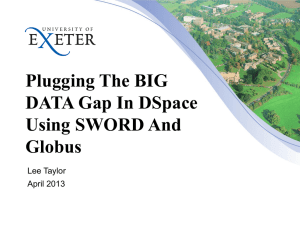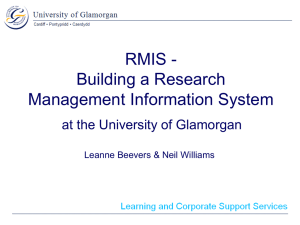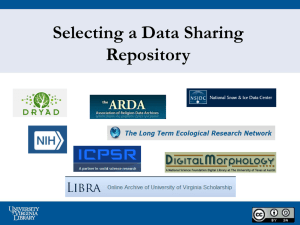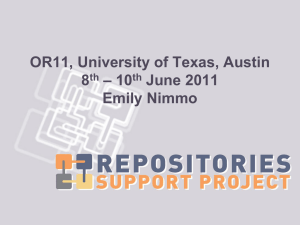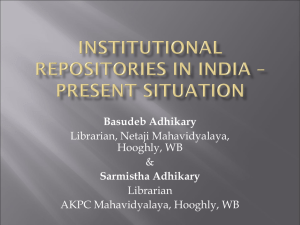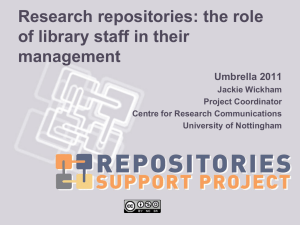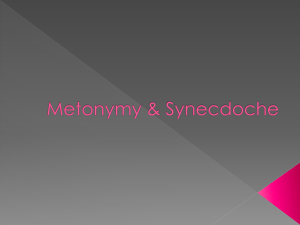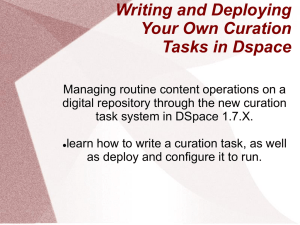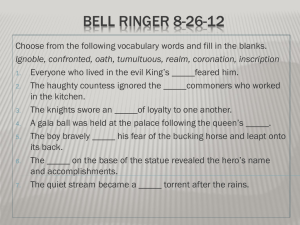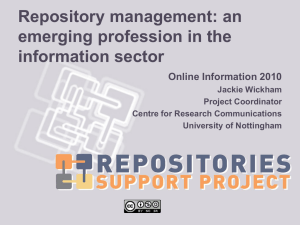UoA Library – core systems
advertisement
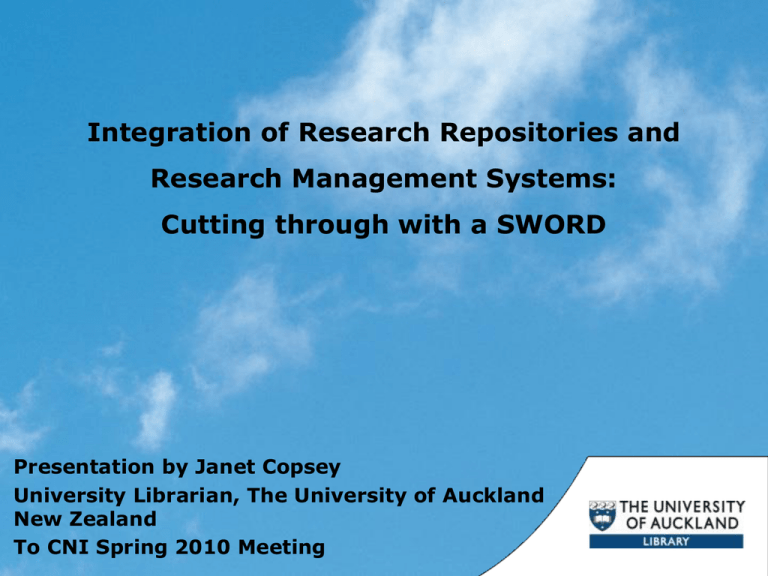
Integration of Research Repositories and Research Management Systems: Cutting through with a SWORD Presentation by Janet Copsey University Librarian, The University of Auckland New Zealand To CNI Spring 2010 Meeting NZ’s largest and highest ranked research university The University of Auckland 31,500 FTE students 4,600 FTE staff including 100 professional librarians UoA Library – core systems Ex Libris – Primo, Voyager, MetaLib, SFX and DigiTool Partner in Primo Central/MetaLib development OCLC VDX interlibrary loan system with enduser requesting and direct interfaces to a number of national and international systems DSpace – Stuart Lewis, UofA Library staff member, was international release manager for latest version of DSpace – 1.6 Kiwi Research Information Service Australian Research Online Understanding the New Zealand environment Research Funding – Core Research New Zealand, and now Australia, has similar funding model to the UK which bases a percentage of core research funding on research outputs assessment. UK = RAE & now REF NZ = PBRF AUST = RQF & now ERA Funding environment creates a driver for research management systems including management of research outputs Government and other funding bodies requirement for improved performance Government wanting to see higher profile internationally for NZ research Higher profile of institutional research on the web also required because of ranking system developments What are some of the drivers for Research Repositories? Improved access to unpublished research such as Doctoral theses Open Access Movement – improved access to research Responsibility of the Library to their institution to enhance the collective memory by archiving research outputs created by academics What do Research Management Systems and Research Repositories have in common? Similar Goals Library-based Research Repositories – primarily “Open Access” with some “Dark Archive” Sharing and standards for interchange built into systems Research Management Systems – primarily internally focused with reports for external requirements Funding & Grant Tracking Proposal Tracking Archive the collective outputs of University staff and make them harvestable where appropriate Resources and compliance Reporting & Research Evaluation Which piece of the puzzle is common? Library based Research Repositories Sharing and standards for interchange Archive the collective outputs of University staff Research Outputs Research Management Systems Funding & Grant Tracking Proposal Tracking Resources and compliance Reporting & Research Evaluation “Modern information systems can only truly thrive when they interoperate with other systems. Institutional repositories are no exception to this rule. Repository software can typically interoperate with other systems in three ways: to get things into the repository; to get things out of the repository; to assist the repository with tasks such as preservation, storage, or authentication.” Lewis, S., Hayes, L., Newton-Wade, V., Corfield, A., Davis, R., Donohue, T., et al. (2009). If SWORD Is the Answer, What Is the Question?: Use of the Simple Web-Service Offering Repository Deposit Protocol. Program: Electronic Library & Information Systems. 43 (4), 407418. http://hdl.handle.net/2292/5315 What are the barriers to integration? Few examples of successful models Technology mis-match between older Research Management Systems and newer repositories Most Research Management Systems have underdeveloped research publications management modules Standards minimal in this area although emerging NISO Background on the Research+ Project at UoA During 2009 the University of Auckland began a process to implement a new Research Management System using InfoEd (US) In 2010 decision made to use Symplectic Elements (UK) for research publications module of the overall system Symplectic will become the integration layer as data entered into this system can be offered up for re-use in other systems (eg InfoEd grants module) and it comes with an “out of the box” (SWORD) upload facility so full text can be uploaded to the existing University of Auckland DSpace repository – ResearchSpace SWORD – an explanation This part of the system uses an upload facility that is seamless to the user Buried behind the scenes is a customised SWORD Deposit mechanism: an Atom Publishing Standard that uploads a file and the associated packet of metadata and maintains the 2 way connection SWORD on Steroids How the model is going to work Citation databases WOS, Scopus, PubMed Management reporting Research Outputs Module API services and direct exports populated with data from RO Module Researcher Web Pages Symplectic Elements 2 way flow Deposit entry point in the RO Module, uses SWORD protocol for deposit Web Visibility ResearchSpace DSpace Repository Problems solved using integrated model Metadata is entered once only and flows into other systems Accurate well formed data is sourced from indexing services/publishers/suppliers wherever possible Full text can be uploaded at anytime and the repository acts as a file store for the system Two way connection between the Research Publications system (Symplectic) and the Research Repository (Dspace) so Permanent URL can be exchanged, & if records are deleted the change flows back to the other system Benefits: Metadata accuracy Automated trawling of citation databases ArchiveX WOS DBLP Scopus PubMed Automatic duplication check with options WOS PubMed Data Sources x 2 Easy manual import Easy export Easy upload of Full text Unresolved issue: Researcher Identifiers Institutions generally have their own identifiers for researchers Governments have assigned identifiers if research funding is tied to the research outputs International initiatives underway to assist verification and identification include: ORCID project – Name Identifier Summit 2009 ISNI – International Standard Name Identifier OCLC – VIAF JISC - Names Project Conclusions Be wary of systems that don’t allow data exchange Create metadata only once – don’t reinvent the wheel Rely on machines to do the work not people as to grow the content in these systems the effort has to be low and the benefits immediate Opportunity to enter publications and associated metadata once and use many times – eg researcher web pages or academic profiles, research reporting, grant proposals, CVs, bibliographies, etc. References/Sources Allinson, J., François, S., & Lewis, S. (2008). SWORD: Simple Web-service offering repository deposit. Ariadne, 54. Allinson, J., & Stevenson, A. (2009). The Cutting Edge of SWORD. Ben Wynne. (n.d.). Online catalogue and repository interoperability study (OCRIS). Retrieved March 21, 2010, from http://www.jisc.ac.uk/whatwedo/projects/scholcommslinks Casting_Net.jpg (JPEG Image, 464x335 pixels) - Scaled (0%). (n.d.). . Retrieved from http://sites.yellow.co.nz/site/actionfish/images/Casting_Net.jpg FereshtehPresentationDARTS_12_June_2009.pdf. (n.d.). . Retrieved from http://www.cilip.org.uk/getinvolved/special-interest-groups/ucr/Documents/FereshtehPresentationDARTS_12_June_2009.pdf Flickr: dty2dty2's Photostream. (n.d.). . Retrieved March 22, 2010, from http://www.flickr.com/photos/dty2/ Lewis, S., Hayes, L., Newton-Wade, V., Corfield, A., Davis, R., Donohue, T., & Wilson, S. (2009). If SWORD is the answer, what is the question? Program - electronic library and information systems, 43(4), 407-418. doi:http://dx.doi.org/10.1108/00330330910998057 Open Access http://hdl.handle.net/2292/5315 Look, H. (2009). Embedding repositories in research management systems: final report (Monograph). Retrieved from http://ie-repository.jisc.ac.uk/408/ Morgan, T., Lang, A., Wood, M., Harrison, A., Picasso, V., Ruthven, T., Quilliam, J., et al. (2009). ARROW HERDC Working Group final report. 2009. Retrieved from http://hdl.handle.net/1959.3/50374 UKOLN, J. (n.d.). Welcome to SWORD APP — SWORD Site. Retrieved March 21, 2010, from http://www.swordapp.org/
